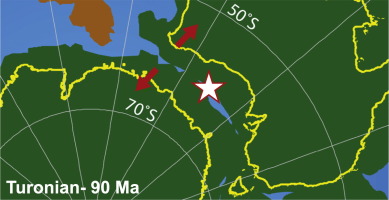当前位置:
X-MOL 学术
›
Gondwana Res.
›
论文详情
Our official English website, www.x-mol.net, welcomes your feedback! (Note: you will need to create a separate account there.)
Late Cretaceous stratigraphy and paleoceanographic evolution in the Great Australian Bight Basin based on results from IODP Site U1512
Gondwana Research ( IF 6.1 ) Pub Date : 2020-07-01 , DOI: 10.1016/j.gr.2020.01.009 K.G. MacLeod , L.T. White , C.C. Wainman , M. Martinez , M.M. Jones , S.J. Batenburg , L. Riquier , S.J. Haynes , D.K. Watkins , K.A. Bogus , H.-J. Brumsack , R. do Monte Guerra , K.M. Edgar , T. Edvardsen , D.L. Harry , T. Hasegawa , R.W. Hobbs , B.T. Huber , T. Jiang , J. Kuroda , E.Y. Lee , Y.-X. Li , A. Maritati , L.K. O'Connor , M.R. Petrizzo , T.M. Quan , C. Richter , M.L.G. Tejada , G. Tagliaro , E. Wolfgring , Z. Xu
Gondwana Research ( IF 6.1 ) Pub Date : 2020-07-01 , DOI: 10.1016/j.gr.2020.01.009 K.G. MacLeod , L.T. White , C.C. Wainman , M. Martinez , M.M. Jones , S.J. Batenburg , L. Riquier , S.J. Haynes , D.K. Watkins , K.A. Bogus , H.-J. Brumsack , R. do Monte Guerra , K.M. Edgar , T. Edvardsen , D.L. Harry , T. Hasegawa , R.W. Hobbs , B.T. Huber , T. Jiang , J. Kuroda , E.Y. Lee , Y.-X. Li , A. Maritati , L.K. O'Connor , M.R. Petrizzo , T.M. Quan , C. Richter , M.L.G. Tejada , G. Tagliaro , E. Wolfgring , Z. Xu

|
Abstract The Upper Cretaceous sedimentary sequence at International Ocean Discovery Program Site U1512 in the Ceduna Sub-basin of the Great Australian Bight represents a continuous, > 690 m thick interval of black silty clay and claystone spanning the lower Turonian through Lower Campanian (~10 million years). Sediments were deposited in an elongate, ~E-W oriented, ~2500 km long rift system that developed between Australia and Antarctica with an open-ocean connection to the west and a continental bridge to the east. Site U1512 cores provide a unique, continuous record of Late Cretaceous deposition in the Ceduna Sub-basin on the hanging wall of the Wallaroo Fault Zone. Study of U1512 samples could provide both an important high-latitude, southern hemisphere perspective on climatic evolution during the peak and demise of the Cretaceous hothouse and an offshore record of the sedimentation history in the basin during the Late Cretaceous portion of the Gondwanan breakup. The Upper Cretaceous sequence at Site U1512 is notable for its lithologic uniformity. Burrow-mottled to massive claystone and silty claystone make up the majority of the almost 700 m section, while rare (n = 28) isolated, 2 to 21 cm thick medium to fine sandstone beds are a minor lithology. Macrofossils present include common inoceramids and rare occurrences of other bivalves and ammonites. Microfossils include common occurrences of calcareous nannofossils, agglutinated and calcareous benthic foraminifera, radiolaria and organic-walled dinoflagellate cysts as well as rare, small, surface dwelling planktonic foraminifera. Carbonate (
中文翻译:

基于IODP Site U1512结果的大澳大利亚湾盆地晚白垩世地层和古海洋演化
摘要 大澳大利亚湾 Ceduna 次盆地国际海洋发现计划站点 U1512 的上白垩统沉积层序代表了连续的、> 690 m 厚的黑色粉质粘土和粘土岩层,跨越下图伦阶到下坎帕阶(约 1000 万年)。沉积物沉积在一个细长的、~EW 方向、~2500 公里长的裂谷系统中,该裂谷系统在澳大利亚和南极洲之间形成,西部与公海相连,东部有大陆桥。站点 U1512 岩心提供了一个独特的、连续的白垩纪晚期沉积记录,记录了塞杜纳盆地瓦拉鲁断层带上盘上的沉积物。U1512 样本的研究可以提供一个重要的高纬度,南半球对白垩纪温室顶峰和消亡期间气候演化的看法,以及冈瓦纳大陆分裂晚期白垩纪晚期盆地沉积历史的近海记录。Site U1512 的上白垩统层序以其岩性均匀性而著称。洞穴斑驳到块状粘土岩和粉质粘土岩占近 700 m 剖面的大部分,而稀有 (n = 28) 孤立的、2 至 21 cm 厚的中至细砂岩床是次要的岩性。存在的大型化石包括常见的 inoceramids 和罕见的其他双壳类动物和菊石。微化石包括常见的钙质纳米化石、凝集和钙质底栖有孔虫、放射虫和有机壁甲藻囊肿以及罕见的、小的、表面栖息的浮游有孔虫。碳酸盐 (
更新日期:2020-07-01
中文翻译:

基于IODP Site U1512结果的大澳大利亚湾盆地晚白垩世地层和古海洋演化
摘要 大澳大利亚湾 Ceduna 次盆地国际海洋发现计划站点 U1512 的上白垩统沉积层序代表了连续的、> 690 m 厚的黑色粉质粘土和粘土岩层,跨越下图伦阶到下坎帕阶(约 1000 万年)。沉积物沉积在一个细长的、~EW 方向、~2500 公里长的裂谷系统中,该裂谷系统在澳大利亚和南极洲之间形成,西部与公海相连,东部有大陆桥。站点 U1512 岩心提供了一个独特的、连续的白垩纪晚期沉积记录,记录了塞杜纳盆地瓦拉鲁断层带上盘上的沉积物。U1512 样本的研究可以提供一个重要的高纬度,南半球对白垩纪温室顶峰和消亡期间气候演化的看法,以及冈瓦纳大陆分裂晚期白垩纪晚期盆地沉积历史的近海记录。Site U1512 的上白垩统层序以其岩性均匀性而著称。洞穴斑驳到块状粘土岩和粉质粘土岩占近 700 m 剖面的大部分,而稀有 (n = 28) 孤立的、2 至 21 cm 厚的中至细砂岩床是次要的岩性。存在的大型化石包括常见的 inoceramids 和罕见的其他双壳类动物和菊石。微化石包括常见的钙质纳米化石、凝集和钙质底栖有孔虫、放射虫和有机壁甲藻囊肿以及罕见的、小的、表面栖息的浮游有孔虫。碳酸盐 (



























 京公网安备 11010802027423号
京公网安备 11010802027423号